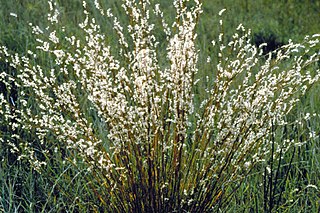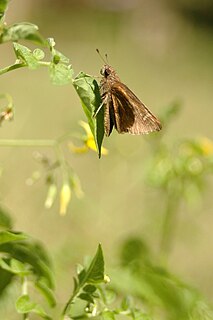A genus is a taxonomic rank used in the biological classification of living and fossil organisms, as well as viruses, in biology. In the hierarchy of biological classification, genus comes above species and below family. In binomial nomenclature, the genus name forms the first part of the binomial species name for each species within the genus.
Binomial nomenclature, also called binominal nomenclature or binary nomenclature, is a formal system of naming species of living things by giving each a name composed of two parts, both of which use Latin grammatical forms, although they can be based on words from other languages. Such a name is called a binomial name, a binomen, binominal name or a scientific name; more informally it is also called a Latin name. The first part of the name – the generic name – identifies the genus to which the species belongs, while the second part – the specific name or specific epithet – identifies the species within the genus. For example, humans belong to the genus Homo and within this genus to the species Homo sapiens. Tyrannosaurus rex is probably the most widely known binomial. The formal introduction of this system of naming species is credited to Carl Linnaeus, effectively beginning with his work Species Plantarum in 1753. But Gaspard Bauhin, in as early as 1623, had introduced in his book Pinax theatri botanici many names of genera that were later adopted by Linnaeus.

Cortaderia is a genus of South American and Central American plants in the Poaceae grass family.

In zoological nomenclature, a type species is the species name with which the name of a genus or subgenus is considered to be permanently taxonomically associated, i.e., the species that contains the biological type specimen(s). A similar concept is used for suprageneric groups called a type genus.

In biological classification, especially zoology, the type genus is the genus which defines a biological family and the root of the family name.
Pampas grass or pampas-grass is a common name which may refer to any of several similar-looking, tall-growing species of grass:

The Andropogoneae, sometimes called the sorghum tribe, are a large tribe of grasses (family Poaceae) with roughly 1,200 species in 90 genera, mainly distributed in tropical and subtropical areas. They include such important crops as maize (corn), sugarcane, and sorghum. All species in this tribe use C4 carbon fixation, which makes them competitive under warm, high-light conditions.

A botanical name is a formal scientific name conforming to the International Code of Nomenclature for algae, fungi, and plants (ICN) and, if it concerns a plant cultigen, the additional cultivar or Group epithets must conform to the International Code of Nomenclature for Cultivated Plants (ICNCP). The code of nomenclature covers "all organisms traditionally treated as algae, fungi, or plants, whether fossil or non-fossil, including blue-green algae (Cyanobacteria), chytrids, oomycetes, slime moulds and photosynthetic protists with their taxonomically related non-photosynthetic groups ."

Leymus is a genus of plants in the grass family Poaceae (Gramineae). It is widespread across Europe, Asia, and the Americas.
- Leymus aemulans - Xinjiang, Central Asia
- Leymus ajanensis - Siberia, Russian Far East, Alaska
- Leymus akmolinensis - Siberia, Kazakhstan, European Russia
- Leymus alaicus - Central Asia
- Leymus altus - Xinjiang
- Leymus ambiguus - mountains of western US
- Leymus angustus - Altai wild rye - China, Mongolia, Siberia, Central Asia
- Leymus arenarius - lyme grass - Europe
- Leymus aristiglumus - Qinghai
- Leymus × buriaticus - Siberia
- Leymus cappadocicus - Turkey, Afghanistan
- Leymus chinensis - China, Korea, Mongolia, Amur, Siberia
- Leymus cinereus - basin wild rye - western North America
- Leymus condensatus - giant wild rye - California, Baja California, Coahuila
- Leymus crassiusculus - Qinghai, Shanxi
- Leymus divaricatus - Kazakhstan
- Leymus duthiei - China, Korea, Japan, Nepal, northern India
- Leymus erianthus - Chile, Argentina
- Leymus × fedtschenkoi - Kyrgyzstan
- Leymus flavescens - Alberta, northwestern US
- Leymus flexilis - Kyrgyzstan, Kazakhstan
- Leymus flexus - Qinghai, Gansu, Shanxi
- Leymus innovatus - from Alaska + Northwest Territories to South Dakota + Ontario
- Leymus × jenisseiensis - Siberia
- Leymus karelinii - Xinjiang, Central Asia, European Russia
- Leymus komarovii - China, Mongolia, Korea, Russian Far East
- Leymus kopetdaghensis - Turkmenistan
- Leymus lanatus - Kyrgyzstan, Tajikistan, Afghanistan
- Leymus latiglumis - Uzbekistan
- Leymus leptostachyus - Qinghai, Xinjiang
- Leymus mollis - colder parts of Asia + North America
- Leymus multicaulis - European Russia, Central Asia, Xinjiang
- Leymus × multiflorus - California
- Leymus mundus - Tibet, Gansu
- Leymus nikitinii - Turkmenistan
- Leymus oblongolemmatus - Qinghai
- Leymus obvipodus - Qinghai
- Leymus ordensis - Siberia
- Leymus paboanus - Russia, China, Mongolia, Central Asia, Afghanistan
- Leymus pacificus - California
- Leymus paucispiculus - Qinghai, Gansu
- Leymus pendulus - Qinghai
- Leymus pishanicus - Xinjiang
- Leymus pluriflorus - Qinghai, Gansu
- Leymus pseudoracemosus - Qinghai
- Leymus pubinodis - Xinjiang
- Leymus racemosus - mammoth wild rye - Eurasia from Bulgaria to Mongolia
- Leymus × ramosoides - European Russia
- Leymus ramosus - Eurasia from Crimea to Mongolia
- Leymus ruoqiangensis - Xinjiang, Qinghai
- Leymus salinus - western US
- Leymus secalinus - Siberia, Mongolia, China, Korea, Central Asia, Himalayas
- Leymus shanxiensis - Shanxi
- Leymus sibiricus - Russia from Altai Krai to Magadan
- Leymus × sphacelatus - Tuva
- Leymus spiniformis - Qinghai, Shanxi
- Leymus tianschanicus - Iran, Central Asia, Xinjiang, Inner Mongolia
- Leymus triticoides - creeping wild rye - British Columbia, western US, Baja California, Tamaulipas
- Leymus × tuvinicus - Siberia
- Leymus × vancouverensis - British Columbia, Washington, Oregon, California
- Leymus villosissimus - Yakutia, Magadan, Kamchatka, Alaska, Yukon, Northwest Territories, British Columbia
- Leymus yiunensis - Xinjiang

Tapinanthus is a genus of mistletoe in the family Loranthaceae, endemic to Africa. The name of the genus is derived from the Greek tapeinos meaning "low" or "humble" and anthos meaning flower.

In biological classification, taxonomic rank is the relative level of a group of organisms in a taxonomic hierarchy. Examples of taxonomic ranks are species, genus, family, order, class, phylum, kingdom, domain, etc.

Enodia anthedon, the northern pearly-eye, is a butterfly species of the Satyrinae subfamily that occurs in North America, where it is found from central Saskatchewan and eastern Nebraska east to Nova Scotia, south to central Alabama and Mississippi.

Lerema accius, the clouded skipper, is a butterfly of the family Hesperiidae. It is found in the United States from Georgia west to Texas, south to Florida, and south through Mexico and Central America to Venezuela and Colombia.
Iolaus australis, the eastern sapphire, is a butterfly in the family Lycaenidae. It is found in Zambia and Zimbabwe. The habitat consists of Brachystegia woodland.

Iolaus iulus, the Iulus sapphire, is a butterfly in the family Lycaenidae. It is found in Senegal, Sierra Leone, Liberia, Ivory Coast, Ghana, Togo, southern Nigeria, Cameroon, Gabon, the Republic of the Congo, the Democratic Republic of the Congo, Uganda and Zambia. The habitat consists of forests and cleared lands.
Iolaus ndolae is a butterfly in the family Lycaenidae. It is found in northern Zambia, Malawi, eastern Tanzania and possibly the Democratic Republic of the Congo (Shaba). The habitat consists of forests.
Leptomischus is a genus of plants in the Rubiaceae. At the present time, 7 species are recognized, native to southern China and southeast Asia.
Stenerianthus annamensis is a species of grasshopper in the monotypic genus Stenerianthus. It is in the family Chorotypidae, subfamily Erianthinae. This grasshopper was discovered in central Vietnam.












